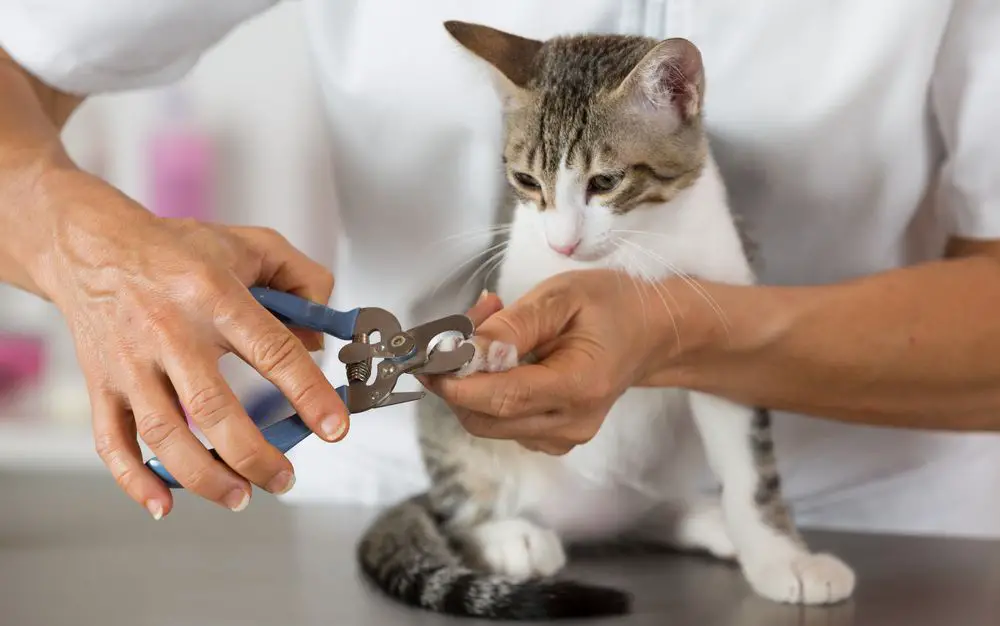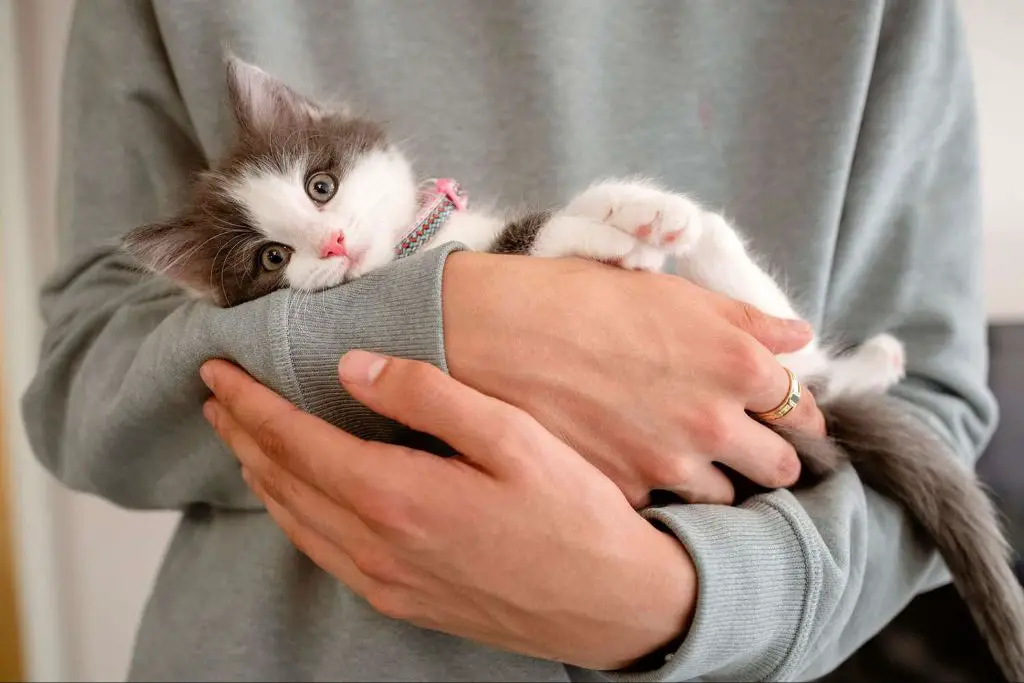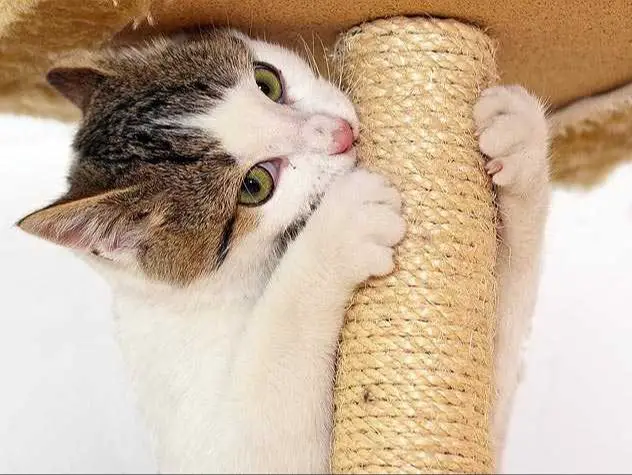Why Do Cats Need Their Claws Trimmed?
Trimming a cat’s claws is an important part of keeping them healthy and preventing problems. Overgrown claws can cause issues for both cats and their owners. Here are some of the main reasons cats need regular claw trims:
Prevents injury from scratches – Sharp, long claws can cause painful scratches to both people and furniture. Trimming the sharp tips helps minimize scratches and injuries.
Helps keep claws a normal length – Cat claws grow continuously and can get overgrown if not trimmed. Long claws can start to curl and become embedded in the paw pads. Trimming keeps them a healthy length.
Avoids problems caused by overgrown claws – Overgrown claws can make it painful for a cat to walk or use their litter box. Long claws can also get caught on fabrics and carpet. Trimming avoids issues caused by overly long claws.
Regular claw trimming every 2-3 weeks helps prevent these issues and keep a cat’s claws neat, tidy and a healthy length. It’s an important part of maintaining good claw health and preventing problems.
How Often Should You Trim a Cat’s Claws?

Veterinarians generally recommend trimming a cat’s claws every 2-4 weeks. Adult cats that go outdoors may need more frequent trims, such as every 1-2 weeks. This is because their claws can get worn down from outdoor surfaces. Indoor cats or less active cats may only need trims every 3-4 weeks.
Kittens should have their claws trimmed more frequently than adult cats, about every 1-2 weeks. This helps get them used to the process while their claws are still soft. It’s a good idea to handle and inspect a kitten’s paws often so they become desensitized to having their feet touched.
In general, the frequency of claw trims depends on the cat’s activity level. More active cats that scratch and climb a lot will need more frequent trims. Less active indoor cats that rarely scratch may need less frequent trims. Observe your cat’s claws and trim them once they start getting long enough to snag on fabric and carpeting.
According to petmd.com, “Cat should have their nails trimmed every 10 days to 2 weeks so that they do not start to curl under.”[1]
[1] https://www.petmd.com/news/view/how-often-should-you-trim-cats-nails-37807
What Happens if You Don’t Trim Your Cat’s Claws?
If a cat’s claws are not trimmed regularly, they can grow in a circle and embed themselves into the cat’s paws, causing significant pain and mobility issues. According to veterinarians, overgrown claws can curl back into the paw pads, leading to infection and discomfort (Source).
In addition, untrimmed claws can make scratching more dangerous. Cats use their claws to scratch for many reasons, including marking territory and stretching. Long, sharp claws can cause deep scratches and injuries to people and furniture. Regular trimming keeps claws blunt and helps prevent excessive damage.
Overall, neglecting to trim a cat’s claws can negatively impact their health and comfort. It’s recommended to trim claws every 2-4 weeks to avoid issues.
How to Trim Your Cat’s Claws
Trimming your cat’s claws will require having the proper supplies on hand. You’ll need a good pair of claw clippers designed specifically for cats, like the Safari Professional Nail Trimmer (https://www.chewy.com/safari-professional-nail-trimmer/dp/153767). It’s also helpful to have treats or catnip handy to relax your cat and reward them during the process. Choose a time when your cat is calm and relaxed.
To get started, gently wrap your cat in a towel or place them on your lap while speaking to them soothingly. Have their paws facing out and start with their front paws. Apply gentle pressure to their paw pads to extend their claws fully. Snip just the sharp tip of each claw at a 45 degree angle, taking care not to cut into the pink quick, as this can cause pain and bleeding.
Work carefully and patiently, taking breaks to offer treats and affection if your cat gets distressed. Pace yourself by doing one paw at a time over multiple sessions until your cat is comfortable having all their claws trimmed.
Claw Trimming Tips and Tricks
Introducing claw trimming slowly with positive reinforcement is important to help keep your cat calm and comfortable with the process. Here are some tips:
- Start by gently handling your cat’s paws and giving treats so they associate it with something positive. According to the Ontario SPCA, this will help them be more tolerant of having their claws trimmed (https://ontariospca.ca/blog/8-tips-for-trimming-your-cats-nails/).
- Try trimming your cat’s claws in different positions, like placing them in your lap or on a table, to see what helps them stay relaxed.
- Only trim a few claws per session in the beginning. Take breaks to reward good behavior with treats or pets.
- Go slowly and remain calm yourself. Cats can sense if you’re stressed.

Building up positive associations with regular claw trims will help make the process easier on both you and your cat over time.
Signs Your Cat’s Claws Need Trimming
There are a few telltale signs that indicate it’s time to trim your cat’s claws:
Claws that are getting too long will start to click loudly on hard floor surfaces as your cat walks around. If you hear these clicking sounds, especially if it seems new or more pronounced, it’s a sign their claws need some maintenance.
Overgrown claws are also more likely to get caught and snagged on fabrics like blankets, carpets, and upholstery. If you notice your cat’s claws getting frequently hooked into materials around your home, a trim can help minimize damage to those items.
Excessively long claws can also lead to increased scratching of people and furniture. Since longer claws are sharper and thicker, they can do more damage with scratches. Trimming them down can reduce the intensity of scratching incidents.
If you notice any of these signs, it’s a good indication that it’s time to break out the clippers and give your cat’s claws a trim.
Claw Trimming Alternatives
While regular claw trimming is the best way to keep your cat’s nails healthy, some cats dislike having their claws clipped. Fortunately, there are a few alternatives to trimming that can help keep your cat’s claws short:

Scratching Posts and Pads
Providing plenty of scratching posts and pads around your home can help trim your cat’s nails naturally as they scratch. The scratching action helps remove the dead outer nail sheaths. Be sure to get tall, sturdy posts that allow for full stretching. Places several around your home near your cat’s favorite sleeping and playing spots.1
Nail Caps
Nail caps like Soft Claws can be glued over your cat’s existing nails to blunt the claws. These need to be replaced every 4-6 weeks as the nail grows out. This protects your home furnishings while avoiding painful trims.2
Declawing (strongly discouraged)
Declawing, or onychectomy, involves amputating the last bone of each toe and carries significant risks. It is inhumane and may lead to pain, infection, and other problems. Declawing is banned in many countries. It should never be performed unless medically necessary in rare cases.3
Trimming Kittens’ Claws
It’s important to start trimming your kitten’s claws at a young age so they become accustomed to the process. Kittens have very sharp little claws that can do damage if left untrimmed. Start trimming sessions when the kitten is around 3-4 weeks old.
Go slowly and keep the first few sessions very brief, just a snip or two per paw. It’s a new sensation for them. Offer treats and praise throughout to reinforce that nail trims are a positive experience. Over time, gradually increase the length of each session as the kitten becomes more comfortable.
Stay patient and calm during the process. If the kitten resists or gets squirmy, don’t force it. Take a break and try again later. With positive reinforcement and frequent handling of their paws from a young age, kittens will learn to tolerate nail trims as part of their regular routine.
It’s ideal to trim kittens’ claws every 1-2 weeks. At this age their nails are very sharp and grow quickly. Establishing a routine sets you both up for success. Be sure to use a nail trimmer made specifically for cats to avoid splintering their delicate nails.
Trimming Older Cats’ Claws
As cats age, you may need to take some additional precautions when trimming their claws. Older cats often have arthritis or joint pain that makes nail trims more difficult. You may need to gently restrain or wrap your senior cat in a towel to keep them calm and still during the process. Go slowly and carefully, watching for signs of discomfort. Stop immediately if your older cat seems distressed. Trim only one or two nails per session until your cat is comfortable. Reward them afterward with treats and affection.
The claws of elderly cats may thicken and curve more, making them difficult to trim. Invest in quality clippers designed for older cats to ensure a clean cut. Blunt clippers will crush the nail instead. Look for signs that your senior cat’s claws are overgrown and no longer retracting fully. Their claws can sometimes grow into the paw pads if untrimmed. Your vet can show you the safest technique for trimming an arthritic cat’s nails to avoid pain. Seek advice if your aging kitty struggles with grooming their claws independently. With some patience and care, you can keep your senior cat’s nails trimmed for their health and comfort.

When to Seek a Vet’s Help
As a cat owner, you can likely handle trimming your cat’s claws at home. However, there are some situations where it’s best to seek professional help from your veterinarian:
If your cat’s nails have become severely overgrown and embedded in the paw pads, it’s important to have a vet trim them. Trying to cut overgrown nails at home could cause injuries. Vets have the proper tools and training to safely trim overgrown nails.
Some cats are highly resistant to claw trims. If your cat struggles excessively or becomes aggressive when you try to trim their nails, a vet visit may be needed. Vets can use towels or muzzles to keep cats calm during the process. They can also trim the nails quickly to minimize stress.
Lastly, if you accidentally cut the quick or your cat’s skin during trimming, causing bleeding or pain, take them to the vet right away. Vets can properly treat and bandage any wounds. They can also suggest techniques to avoid future trimming injuries.
While claw trims are often a simple at-home task, vets provide an important service when issues arise. Don’t feel bad about seeking professional help for your cat’s nail care. The priority is keeping both you and your cat safe during the process.

